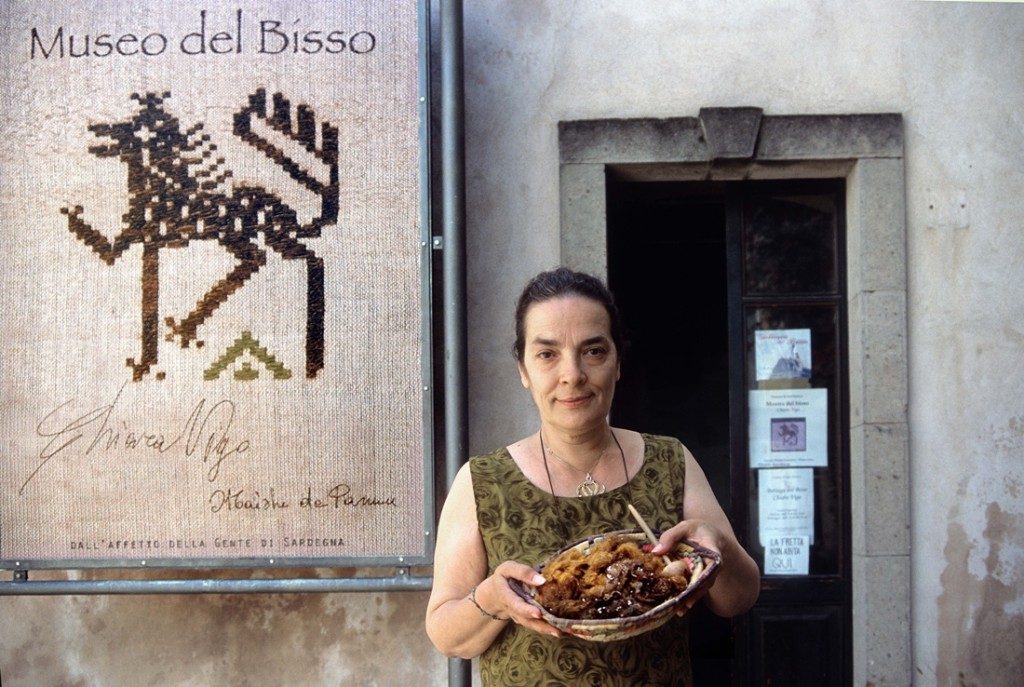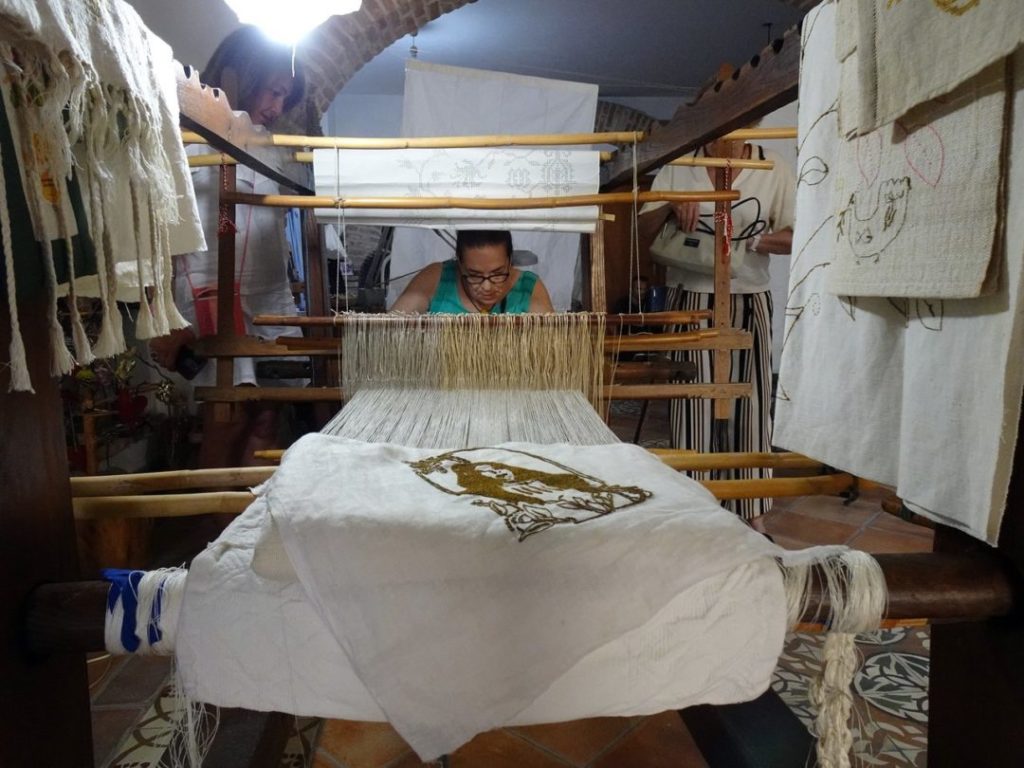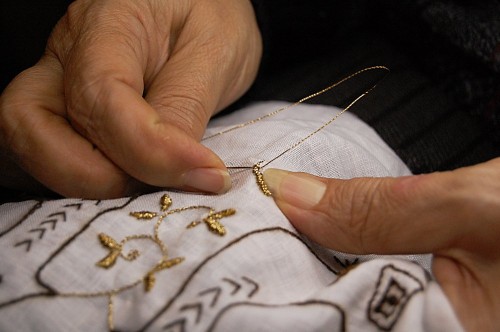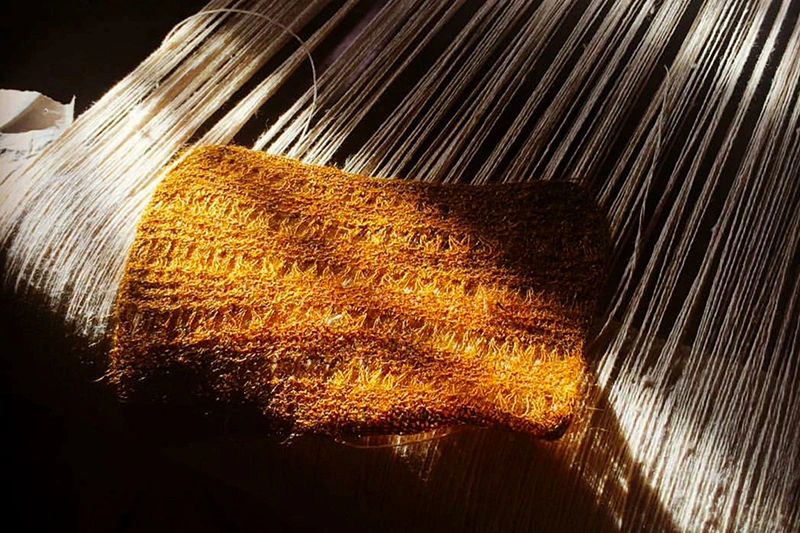A weaver of sea silk
As the sun rises and sets, Chiara Vigo can often be found lovingly singing mystical chants to Sardegna’s crystalline waters. It is in the quiet of these moments of dawn and dusk that she shares her prayers with the creations that lie just beneath the surface. Vigo glides into the midnight blue sea, guided by the light of the moon as the Italian coast guard keeps watch. These lucid waters hold a secret that only Vigo knows.
Each spring, Vigo dives off the coast of Sant’Antioco island in Sardinia on a mission to collect the silky-smooth threads of the pinna nobilis, a rare species of Mediterranean clam which today risks extinction, which she then cleans, spins and weaves into beautiful designs. Neither artist or artisan, Vigo sees herself as simple maestro, someone who passes on her art to others as a gift.

The art of Byssus
Every aspect of Chiara’s art, from the sea silk harvesting to natural dyeing to embroidering the shimmering threads, is done with the intention to share these golden masterpieces with the world. Chiara has taken an oath to the sea, as her grandmother and generations of women before her did. Her art must never be sold. She is a vessel, sharing the intricate and magical bissi di mare with all, just like the sea belongs to everyone. Legend has it that those who have broken this pledge have been cursed and met their fates with catastrophic events.
Having been awarded with the Italian Republic’s highest honour of knighthood, Chiara has been dutifully practicing her technique for more than 50 years. While many at her age make plans to retire, every day Vigo plunges 15 metres deep into the water off Sardegna’s southernmost coast to source these wispy thin fibres, making sure to take them from the side tips of the shell with her miniature blade and never the bottom. This is done to ensure she doesn’t harm the precious mollusc. It will take her up to 300 dives to assemble 200 grams of sea silk, each shell harvesting ten centimetres of silk threads per year.

Returning to land, Chiara begins the process of desalinating the threads with a 25-day fresh water immersion, ensuring the water is consistently changed every three hours. Using a magnifying glass, she delicately lays out the threads to dry before one final brushing and cleaning to remove any further lingering residue. The dyeing process then begins. Chiara gently colours the silk thread using natural plant and marine-based ingredients including algae, top-secret spices, pomegranate juice and lemon seeds in her 124 dye adaptations. On her 200-year-old loom, Vigo spins anincredibly fine thread with the consistency a third of a strand of human hair, resulting in a glimmering piece of art.
A disappearing tradition
The noble pen shell and it’s extraordinary bisso di mare (sea silk byssus) are not the only ones facing endangerment. Chiara is the last of twenty-four generations who have for millennia dived off the coast of Sant’Antioco collecting this precious material. Many say Vigo is the last surviving seamstress of this mystical sea silk. Chiara passed on the tradition to her daughter who has since left the tiny fishing village to make a home in Dublin. Without a next heir apparent, the glimmering golden silk fibres may cease to exist above the sea.

The matriarchal sea weaving traditions of Chiara’s family date back over 5,000 years to the women in Mesopotamia. The gleaming golden threads were used to embroider robes for noble kings, as well as in the fashioning of religious garments for pharaohs, popes and clerics. The magical strands are noted throughout the bible and also referenced on the Rosetta Stone.
Remaining steadfast to her oath, patrons continue to support Chiara and her incredible talent with donations left in her studio in Sant’Antioco while she continues to gift her enchanted creations for people to enjoy in museums around the world, including in Rome, Paris, London and New York. More recently, the private Museo del Bisso museum was established in Sant’Antioco to help ensure this art remains alive with funding provided by the region. Visits for individuals and groups up to 12 people may be made with advanced reservation by directly contacting Chiara via email.
